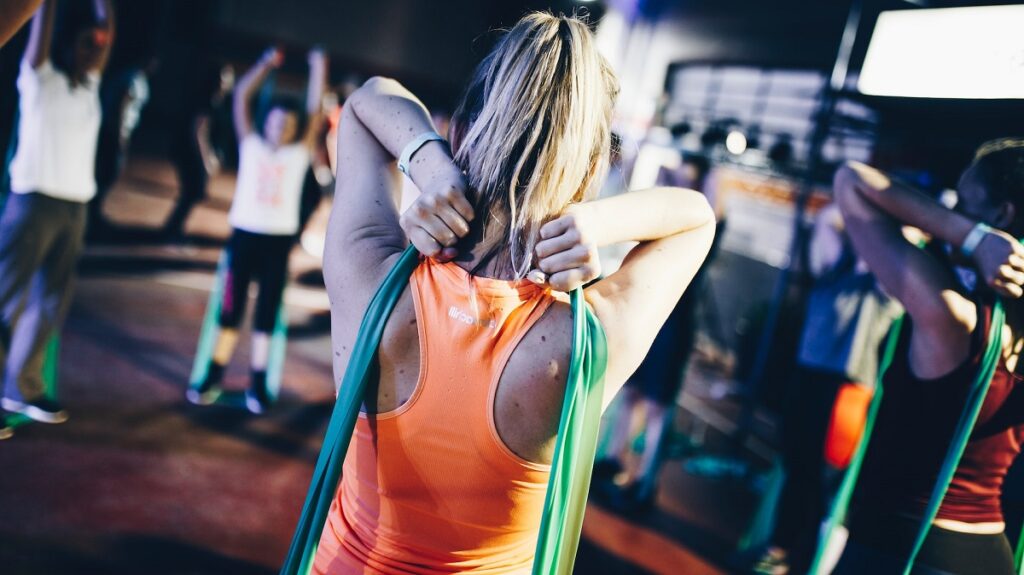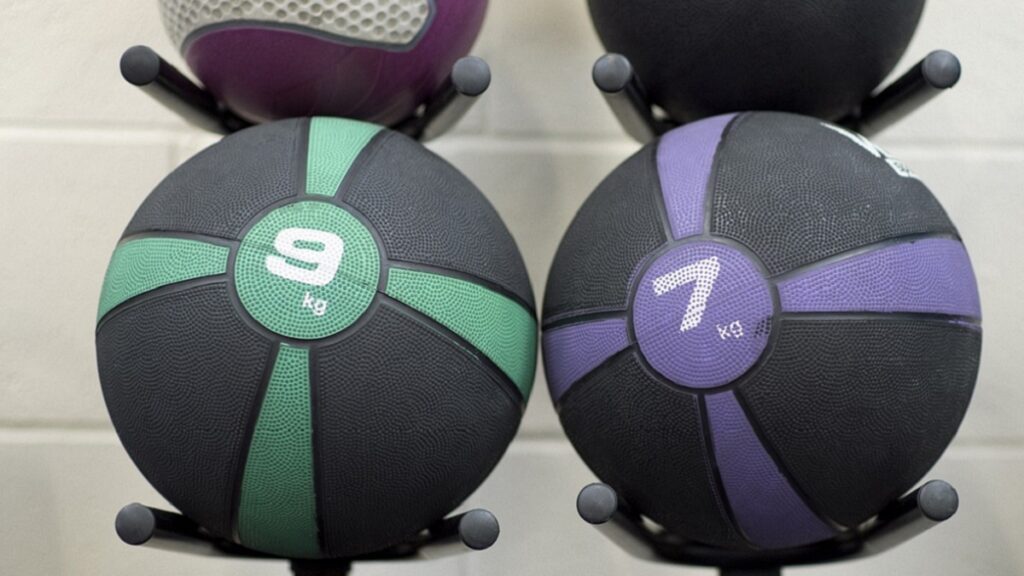Have you struggled with improving strength, muscular endurance, and postural balance? I’m going to discuss a practical exercise to help you out. This affordable training equipment can benefit people of every age or fitness level. However, they are often given a poor rap and frequently ignored since they are not commonly found in gyms. But don’t be fooled by their simplicity. They deserve a spot in the tool cabinet of even the most known athlete. I had a shoulder problem until I did the loop band shoulder exercises.
Loop bands are suitable for functional fitness training before a hard workout. Resistance bands are good for the shoulders as they keep your form in check. Also, resistance band exercises improve muscle balance, control, and stability, stretching and warming your power.
Keep reading to learn more.
Are Loop Band Shoulder Exercises Practical?
Yes, loop band shoulder exercises are practical and beneficial in reducing body fat and increasing muscle strength to the same degree. What looks like a giant rubber band can put a little snap into your shoulder workout routine. They’re great equipment that are excellent for shoulder exercises.
Loop bands can be as practical as free weight training if you actively push yourself. In addition, bands can offer training for people with grip or movement issues.
We all understand how crucial strength training is. For example, in addition to aiding in strength development, it can prevent muscular degeneration as we age. Increasing muscle mass can also speed up metabolism. While bodyweight-only exercises like squats and lunges might help you gain some strength, adding resistance is frequently the key to increasing your strength.
Here is how you do the loop band shoulder exercises:
- Straighten the band out in front of your head as you extend your hands to the sides and lift your arms to shoulder height
- Pull the band apart. Hold on to this position for a short while
- Keep your shoulder blades down and away from your ears as you slowly return to the starting position.
Are Resistance Bands Good For The Shoulder?
Resistance bands are suitable for shoulder workouts because they can increase functional fitness while reducing pain in injury-prone regions. They are easy to carry and ease shoulder pain without using dumbbells or other equipment.
They are cheap and offer a variety of difficulty levels to keep you engaged and moving toward your fitness goal.
Bands are excellent for building muscular mass, but they are also helpful for prehab, which can help you stay healthy in the first place.
They also allow you to warm up while still providing prehab benefits actively. Shoulder pain decreases by strengthening the front of your shoulder muscles and stabilizing the left side.
It’s the best workout at home or with a personal trainer to work on your upper body. This exercise improves upper back left side posture by bringing the shoulder blades together and working on internal position.
What Are Loop Bands Good For?
Loop band shoulder exercises are excellent for strained shoulders and repairing muscles. But what’s a resistance band? It is an elastic band used for weight training. It’s frequently used in physical therapy to encourage easy strength regrowth, especially by patients suffering from muscular injuries.
For many users, their flexibility and minimal weight are of great benefit. When an untrained person starts training for the first time, they have a massive time for adaptation, known as newbie gain.
Band training was once used for muscle healing but is now a popular general fitness and strength tool. Usually, the bands are color-coded to show various resistance levels, and users must choose the proper level.
Manufacturers used to make bands from surgical tubing. They are easy to use, and their light weight makes them great for use while traveling and in shoulder strength training sessions.
How Do You Train Your Shoulders With A Resistance Band?
You train your shoulders with a resistance band by:
- Placing your arms straight out in front of you while holding the bar
- Keeping your elbows bent and lengthening your spine.
- Converging the shoulder blades and holding onto this position for a brief period.
- Slowly returning to the initial position.
Do 1-3 sets of 8-15 repetitions for each set of loop band shoulder exercises, or adjust as your doctor, physical therapist, or personal trainer instructs.
Before switching to a stronger band, practice the activities with a lighter one.
Make controlled, steady motions and avoid moving, rocking, or swinging.
This exercise tones your lower back and rear delts, which can aid in reducing and avoiding rounded shoulders.
It also improves shoulder strength, which helps in overhead movements. This exercise is excellent for those who engage in activities that make them bend forward.
How Long Does It Take To See Results From Resistance Bands?
You will see results in two to four weeks of working with a resistance band. So, bodybuilders should frequently include loop band shoulder exercises in daily and weekly routines. Strength gains from resistance training are noticeable right away.
Nonetheless, your muscles need at least a day of recovery time after performing the exercises at the same force.
Many of us become frustrated when enough time has passed, and we are still waiting for results. Depending on the workout duration and intensity, you may see effects after just one workout. For others, it might take a little longer. Don’t fret about it; just keep working out.
It will help if you are disciplined and patient to see the actual impact of a new routine.
Your goals and demands should guide the design of your resistance band training plan.
Therefore, you should do loop band shoulder exercises as much as you feel comfortable.
How Many Reps Should I Do With Resistance Bands?
You should do eight to twelve repetitions of the loop band shoulder exercises. Increase the number of repetitions to 12 to 30 to increase patience. Also, you should do two to six reps of three to four exercises that work the entire upper or lower body that would make up a decent workout.
By using heavy resistance, you can increase the size and strength of your muscles.
Begin slowly, and you should expect to feel tired after six to ten repetitions of an activity.
Two to six sets of three to four exercises that work the entire upper or lower body would make it a great workout.
Suppose each loop band shoulder exercise set lasts one minute with a minute of rest; it will take 12 minutes to perform 2-3 different exercises. It would take 48 minutes to complete six sets of four activities with a 1- minute break between each set.
How Often to Use Resistance Bands?
You can use resistance bands up to six days a week to develop a contoured physique and increase your muscular endurance. For loop band shoulder exercises, you should wait two days after engaging a key muscle group to engage the muscle again.
Each key muscle group can revive after two days without direct stress.
Thankfully, being fully dedicated to starting a new fitness and health journey is always thrilling.
However, using resistance bands daily wouldn’t be optimal because your muscles won’t recover completely.
Nonetheless, if you follow the workout schedule below or a similar one, you can work out with the bands up to six times per week while allowing each muscle group adequate time to recover.
When Should I Start Using Resistance Bands?
You can start using resistance bands just after getting into fitness. They are simple to use. So, if you want to tone your muscles and boost your shoulder mobility, you should start using them immediately!
For beginners, resistance bands are a great choice. Besides, you can adjust the resistance level to fit your expertise level. Hence, they’re user-friendly.
It’s easy to learn how to use resistance bands. In addition, because of its low impact, this style of strength training is excellent for people of all fitness levels.
They are made of latex, rubber, or cloth and available in different tensions or levels of resistance.
The band is typically light, medium, heavy, or exceedingly heavy.
Bands work the stabilizing muscles, which let your larger muscles and joints move while supporting them, lowering the chance of injury.
Therefore, they are a safe and impact-free option for beginners.
What Tension Should I Use?
The tension you should use is a light band until you get used to the sensation. Consider the strength or pressure when investing in a resistance band. Twelve pounds of resistance is the ideal starting point. I suggest this band if you’ve been exercising but have never used it.
Select a problematic band level that allows you to cross your entire range of motion. A softer band is frequently needed on the upper arms to guarantee proper shape.
Generally speaking, shoulders require more resistance because they are stronger than weights.
Manufacturers often refrain from regularly classifying them as light, medium, heavy, and extra heavy.
You could make the band heavier if you’re using it for pull-ups or another exercise requiring support for more of your body weight.
As you develop the strength, you can make the band tighter.
Excellence Resistance Band Shoulder Exercises You Should Try!
Resistance bands are lightweight and let you hit every angle of your shoulders in the best way possible. As with any other muscle group, when doing loop band shoulder exercises, you want to target them all fairly and evenly so they grow together.
Do you want to grow your shoulders but don’t know how to go about it? Here is the good news, you don’t need a machine, barbell, or even stepping foot in the gym.
Here are ways to do the shoulder exercise.
- Position yourself on the resistance band loop at one end. With your toes pointed forward, your feet should be shoulder-width apart. Holding the opposite end of the circle in your hands would be best. In an overhand position, your grip should also be shoulder-width apart. At the same time, bring your hands up to your shoulder height.
- Hold it at the top and then return to the starting position.
Can You Build Big Shoulders With Resistance Bands?
Yes, you can build big shoulders with resistance bands since they provide a wide range of alternatives to traditional cable. You can get a great shoulder workout almost anywhere. There are various resistance band exercises you can start using today to build big and great shoulders.
With the help of these exercises, lifters of all skill levels may discover how bands can enhance muscular growth, strengthen the joints, and spice up boring routines.
The use of bands might be an excellent substitute for free weights. Secondly, they might give your shoulders the push they need to increase their size and strength.
They’re also a flexible and safe option to grow your shoulders. Also, every part gets included.
The good news is that trainers can use most resistance band sets. Thus, learning how to select the appropriate resistance level is essential.
Nevertheless, with so many choices, you may need to figure out which set is best for you.
Is A Resistance Band Better Than Weight?
A resistance band is better than weight training since you control the tension more. Bands are an excellent option for beginners and people starting their workout routine after a break. They are cheaper than weights. They are also light, making them easy on holidays or work trips.
Additionally, bands are a great option compared to weight if you are recovering from an injury, have recently given birth, are pregnant, had an illness that prevented you from exercising or are new to fitness.
Since the bands often come in packs with various resistances, you may quickly advance to another activity as your power increases.
People feel more confident using them since they are simpler to operate, and you can decide how intense you want the resistance to be when you stretch the band.
Are Loop Bands Safe?
Since it does not peel, break, or snap during use, the loop band is one of the safest band designs. While doing any workout, it stays in place because of its broad, soft fabric and grip. Resistance bands are harmless but can be dangerous if misused.
Many lifters and personal trainers often use resistance bands inappropriately and incorrectly since they are unaware of the risks.
Avoiding overdoing it and using good exercise techniques are essential when using resistance bands. Still, it’s also important to follow these simple safety precautions to prevent accidental injuries that you could have avoided.
Here are some precautions to take when using resistance bands during the loop band shoulder exercises.
- Never drag the bar up to your face
- Check the handles and bands before each usage.
- Examine the item for rips, tears, cracks, scratches, punctures, and discoloration
- Do not twist the band
- Slowly begin every exercise to maintain band strength
FAQs
Resistance Band Storage and Maintenance Guidelines
To maximize safety by reducing the risk of the resistance bands breaking, follow the instructions below to properly store and maintain resistance bands.
- Keep your bands out of the direct sunshine
- Keep bands away from sources of heat
- Also, it would help if you kept bands from a cold or outdoor location
- You should not shorten Latex bands with handles; you should not shorten strength bands by tying knots because doing so increases the risk of the band snapping
- Don’t tie Latex bands with handles and strength around an anchor because doing so can shorten the band’s lifespan and even cause it to break.
- Only stretch the band up to two to five times its initial length
- Never unwind a resistance band when it is taut
- Make sure the anchor is solid and stable
Is Resistance Bands Color Coded?
Resistance bands are commonly color-coded to indicate different levels of resistance. The stress they offer you while working out determines the resistance level. Their colors can change slightly from one manufacturer to another.
The trainer can divide the resistance band into four primary categories: light, medium, heavy, and extra-heavy.
Blue/heavy medium resistance is ideal for people beginning a strengthening program or enhancing muscle endurance. More experienced trainees who require more severe opposition when doing the loop band shoulder exercises can use the higher levels (black/extra heavy).
Usually, presume the brighter colors offer less resistance than dull colors. Who can blame you if you need to find the tiny reference card with these sets? A few niche businesses like to experiment with colors for branding purposes. If you’re concerned that you’ll lose track of which band you just used, mark each with a permanent marker as soon as you buy it, indicating the resistance level.
Conclusion
Depending on your desired options, these flexible latex bands for loop band shoulder exercises frequently come in color-coded sets of 4, 5, 6, or 8. They resemble tiny rubber or latex loops. Their different colors may vary slightly from the manufacturer. Besides, they are adaptable regarding the exercises you can perform with them and are also effortless to store.
The most significant exercises are, without a doubt, the loop band shoulder exercises.



